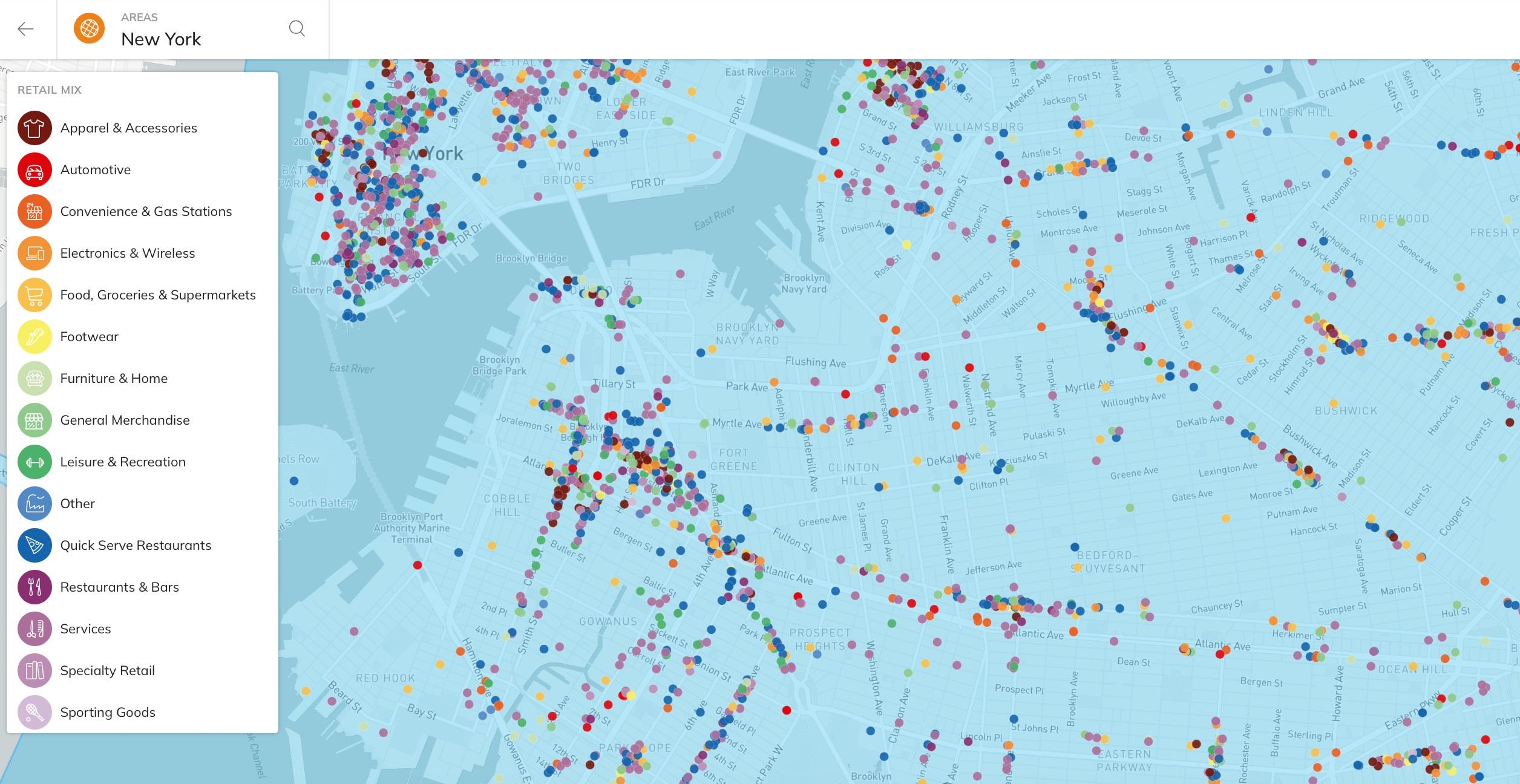Points of Interest (POI) are the starting point for analyzing a location. Businesses and retailers rely on location data analysis to discover new business locations, adjust store hours, manage inventory, and understand competitors. Through the strategic analysis of POI data, companies can gain a more comprehensive picture of consumer behaviors and patterns, thereby enhancing their decision-making processes. What makes POI data so invaluable is its ability to reveal trends about how people move and interact with their environment, allowing businesses to tailor their strategies effectively.
Jump to:
- What is a POI?
- Examples
- What is a POI database
- Where to find POI data
- Data collection
- How to create a POI
- How to analyse a POI
What is a POI
A point of interest (POI) in retail means a strategic location that attract consumers, offering potential benefits to both businesses and customers. A retail store itself can be a POI, along with food courts, hotels, entertainment venues, and tourist attractions. These locations serve as key drivers of foot traffic, enhancing the overall shopping experience.
At pass_by, we offer the highest in market accuracy with 94% correlation to ground truth, over 15 data inputs, and a full 90 days of predictive feeds. Book a call now.
Examples
When considering examples of points of interest, your mind might immediately jump to iconic structures and locationssuch as the Eiffel Tower in Paris or the ancient ruins of Machu Picchu in Peru. These are classic tourist attractions that are well known globally. However, points of interest are not limited to the most famous destinations.
In your own city or town, you might find POIs in places you visit regularly or somewhere particularly unique. For instance, a bustling local market, a trail for a morning jog, or even a historical monument could all serve as points of interest. These locations offer unique insight into the area’s culture, history, and attractions, drawing both locals and tourists seeking exploration.
Moreover, POIs extend beyond tourist activities; they’re also vital in practical aspects, such as in automotive navigation systems. These systems often highlight necessary stops like gas stations, rest areas, or dining establishments, ensuring comprehensive guidance for longer journeys.
Tourist attraction points of interest
A point of interest can be a tourist attraction. Tourist attractions are defined as a place that draws visitors due to its inherent or exhibited cultural value, historical significance, natural beauty, entertainment opportunities, or unique offerings. Tourist attractions are designed to captivate people’s interest, often becoming central parts of travel itineraries.
Examples of tourist attraction POIs include:
- Eiffel tower
- Buckingham palace
- Disney World
- Las Vegas Strip
These attractions can range from towering landmarks like the Statue of Liberty to vibrant urban spaces like Times Square, each providing a distinct glimpse into the locale’s personality and narrative. Whether you’re visiting an enchanting beach, a riveting historical museum, or an exhilarating theme park, these points of interest invite exploration, offering visitors the opportunity to engage with the essence of a place.
In retail, tourist attractions can be points of interest when choosing a retail location as being close to an attraction naturally pulls in visitors.
Retail points of interest
A point of interest can be a retail location. For retailers, identifying these points can help to discover local competitors, partnerships, discover customer needs, analyze a location for a new store, expansion or closure.
Examples of retail POIs include:
- Santa Monica farmers market
- Tiffany & Co New York, 5th Avenue
- Mall of America
What is a points of interest database?
A points of interest (POI) database is a specialized repository that stores data about various locations deemed important or interesting within a given area or for a specific purpose. For retailers, a POI database is essential for its ability to categorize and sort a vast array of location-based data for analysis.
Beyond mapping applications, these databases serve as invaluable resources for industries such as travel, real estate, and local business development. They enable organizations to craft location-based services and personalized recommendations, significantly enriching user experience. With data sourced from government databases, social media, and user contributions, a POI database offers a comprehensive view of geographical interest points.
Whether you’re conducting market research, analyzing competitor, or researching a new location, POI databases empower you to analyze locations with intuitive and informative insights.
At pass_by, we offer the highest in market accuracy with 94% correlation to ground truth, over 15 data inputs, and a full 90 days of predictive feeds. Book a call now.
Where to find points of interest data
Foundation-level POI data such as the address and coordinates can be found from company websites, social media platforms, government databases, and open platforms like Google Maps. Mapping data for POIs can also be collected by human beings in the real world. However, retailers require more details than just these basics.
Government databases often hold a treasure trove of POI information, especially for landmarks and public amenities. These tend to be more focused on physical and cultural points of interest, providing educational insights along with geographical data.
For details from customers, social media and reviews can be of interest to retailers. In fact, by analyzing conversations and feedback through these channels, businesses can gain insights into customer preferences and emerging trends.
For those looking for more curated data, specialized providers can be of help. Information from POI data providers can vary, but can include details of the foot traffic levels, historical performance of a store, and customer demographics.
At pass_by, we offer the highest in market accuracy with 94% correlation to ground truth, over 15 data inputs, and a full 90 days of predictive feeds. Book a call now.
Points of interest data collection
Data collection for points of interest (POIs) encompasses various methods, each with its unique advantages and applications. This process often begins with gathering raw location data from multiple sources such as satellite imagery, GPS signals, and existing databases.
For POI data that pins a location on a map, methods include:
- Crowd sourced data
- Web scraping
Crowd sourcing
One practical approach involves the use of crowd-sourced data; this taps into the collective input from users who provide information about new or existing POIs. Community-driven platforms allow users to flag changes, additions, or removals, thus ensuring the data stays relevant and up-to-date. Data collection is refined with input from local governments and tourist boards, which often have the most reliable and accurate details about their specific areas.
Web scraping
An emerging method in this digital age is through web scraping, which involves extracting data from various online sources, including business directories and social media platforms. These digital environments offer firsthand information regarding locations of interest, hours of operation, and other relevant details. By integrating AI algorithms, data collection systems can now analyze and rapidly update vast quantities of information, maintaining the richness and relevance sought by users.
The ultimate aim of POI data collection is to feed it into databases that can be queried for insight and strategic decision-making. This helps businesses and individuals alike to understand an area’s dynamics, identify potential development opportunities, or simply find the best spots to visit. The future of POI data holds further promise as technologies evolve, offering even more precise and dynamic information at our fingertips.
For POI data that further analyzes a location, methods include:
- Geolocation services, mapping APIs
- Accurate foot traffic sources
- Satellite imagery
- CRM systems
Geolocation services
Geolocation services and mapping APIs, which help in determining precise coordinates and boundaries. Additionally, integration with software tools that offer foot traffic analysis can provide deeper insights into visitor patterns and behaviors at these locations.
Foot traffic
When evaluating points of interest (POIs), foot traffic data offers valuable insights into consumer behavior, patterns, and preferences.
By analyzing aggregated data collected from various sources like sensors, cameras, and specialized data providers, businesses and planners can understand the volume and flow of people in and around a POI.
This type of analysis aids in assessing a location’s popularity and can inform crucial decisions in areas like retail placement, urban planning, and inventory management.
For instance, a shopping center might utilize foot traffic data to determine peak hours, popular entry points, or which stores attract the busiest crowds. Such insights can facilitate operational improvements, like staff scheduling or targeted advertising, enhancing overall customer experience and increasing potential revenue.
Satellite imagery
Another significant method is utilizing satellite imagery and aerial photography to monitor changes in POIs over time, capturing data on the evolving physical landscape. Furthermore, this data can be enriched by incorporating user-generated content from social media platforms, where real-time updates and reviews can verify and expand upon existing information.
CRM systems
For commercial purposes, businesses often leverage customer relationship management (CRM) systems alongside POI data to enhance personalization and location-based marketing strategies. By doing this, they not only identify prospective opportunities but also engage with their audience more effectively.
How to create a point of interest
Creating a Point of Interest (POI) can be a straightforward but rewarding process that combines both creativity and data accuracy. Start by selecting a location that is distinct and meaningful. Think of it as spotlighting a location on your map that others will find useful or exciting to visit.
Creating a point of interest on Google Maps
One way to make your Point of Interest known is to include its address and location on your Google Business page to include it on Google Maps. If your location is already on Google Maps, claim it to add further information.
For retail businesses, including the store’s location, open hours, and photos can all help to create a POI others can find.
Finally, ensure to keep your information updated. Locations change, businesses evolve, and environments develop, so maintaining your POI with current details ensures it remains relevant and useful. By doing so, you not only create a valuable resource for others but also contribute meaningfully to digital maps and navigation systems worldwide.
How to analyze a point of interest
When it comes to analyzing a point of interest, understanding its significance and the data it holds is key.
Start by identifying the POI. You can do this by identifying your competitors or consider what is close to your store locations or your store locations themselves.
Once defined, you can use advanced location analytics to evaluate foot traffic patterns and visit distributions.
Utilizing robust data visualization tools can transform raw numerical data into readable graphs or maps, offering insights into trends and anomalies. These visual tools allow you to quickly grasp how a POI is functioning and what changes might be necessary.
Analyzing a POI isn’t just about the numbers; it’s about understanding the context and using the insights to enhance decision-making and strategic planning.
At pass_by, we offer the highest in market accuracy with 94% correlation to ground truth, over 15 data inputs, and a full 90 days of predictive feeds. Book a call now.





